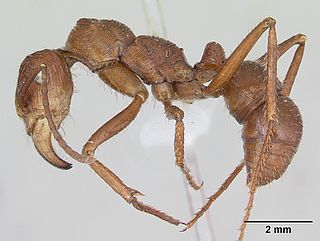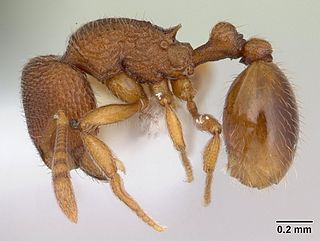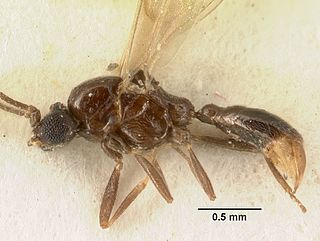
Paratrechina is one of seven ant genera in the Prenolepis genus-group from the subfamily Formicinae. Six species are included in Paratrechina; one of which, the longhorn crazy ant, is a widespread, pantropical pest.

Cataglyphis is a genus of ant, desert ants, in the subfamily Formicinae. Its most famous species is C. bicolor, the Sahara Desert ant, which runs on hot sand to find insects that died of heat exhaustion, and can, like other several other Cataglyphis species, sustain body temperatures up to 50°C. Cataglyphis is also the name of an autonomous rover that won the NASA Sample Return Robot Centennial Challenge inspired by the navigation approaches used by desert ants.

Monomorium is a genus of ants in the subfamily Myrmicinae. As of 2013 it contains about 396 species. It is distributed around the world, with many species native to the Old World tropics. It is considered to be "one of the more important groups of ants," considering its widespread distribution, its diversity, and its variety of morphological and biological characteristics. It also includes several familiar pest species, such as the pharaoh ant and the flower ant.

Leptanillinae is a subfamily of ants. They are further divided into the tribes Anomalomyrmini and Leptanillini.

Leptanilla is a genus of ant in the subfamily Leptanillinae. Like other genera in this subfamily, the queen is fed by the hemolymph of their own larvae, which have specialized processes for this purpose.

Platythyrea is a genus of predaceous ants in the subfamily Ponerinae and the sole member of the tribe Platythyreini.
Avitomyrmex is an extinct genus of bulldog ants in the subfamily Myrmeciinae which contains three described species. The genus was described in 2006 from Ypresian stage deposits of British Columbia, Canada. Almost all the specimens collected are queens, with an exception of a single fossilised worker. These ants are large, and the eyes are also large and well developed; a sting is present in one species. The behaviour of these ants may have been similar to extant Myrmeciinae ants, such as foraging solitarily for arthropod prey and never leaving pheromone trails to food sources. Avitomyrmex has not been assigned to any tribe, instead generally being regarded as incertae sedis within Myrmeciinae. However, its identity as an ant has been challenged, although it is undoubtedly a hymenopteran insect.

Myrmeciites is an extinct form genus of bulldog ants in the subfamily Myrmeciinae of the family Formicidae, which contains three described species and two fossils not placed beyond the genus level. Described in 2006 from Ypresian stage deposits, all three of the described species and one unplaced fossil are from British Columbia, Canada, while the second unplaced fossil is from Washington State, USA. These ants were large, with the largest specimens collected reaching 3 centimetres (1.2 in). The behaviour of these ants would have been similar to extant Myrmeciinae ants, such as solitary foraging, nesting either in the soil or trees, and leaving no pheromone trail to food sources. Due to the poor preservation of these ants, their phylogenetic position among Myrmeciinae is unclear, and no type species has been designated. These ants are classified as incertae sedis in Myrmeciinae, but some writers have classified it as incertae sedis within the insect order Hymenoptera. This reclassification, however, has not been accepted; instead, Myrmeciites remains in Myrmeciinae.

Sphecomyrminae is an extinct subfamily of ants in family Formicidae known from a series of Cretaceous fossils found in North America, Europe, and Asia. Sphecomyrminae contains ten genera, divided into two tribes, Haidomyrmecini and Sphecomyrmini. The tribe Haidomyrmecini contains the five genera Ceratomyrmex, Haidomyrmex, Haidomyrmodes, Haidoterminus and Linguamyrmex, while Sphecomyrmini contains Baikuris, Cretomyrma, Dlusskyidris, Sphecomyrma, and Zigrasimecia. The genus Sphecomyrmodes was formerly placed into Sphecomyrmini; however, in 2016, it was made a synonym of the stem group genus Gerontoformica, which is considered incertae sedis in Formicidae.

Ectatomma is a Neotropical genus of ants in the subfamily Ectatomminae. The genus contains 17 described extant species and one extinct species.

Leptanillini is a tribe of Leptanillinae ants with three extant genera.

Rogeria is a genus of ant in the subfamily Myrmicinae. The genus is known from the Americas, Pacific, and Caribbean. Little is known about their biology.

Yavnella argamani is a species of ant belonging to the Yavnella ant genus. The species was described by Kugler in 1987, it is one of the two species in its genus. It is native to India.

Mayriella is an Indo-Australian genus of ants in the subfamily Myrmicinae. Colonies in this genus are very small, typically consisting of 50 - 100 individuals.

Epelysidris brocha is the only species of ant in the genus Epelysidris. Described by Barry Bolton in 1987 in Borneo, the species is only known from soil in tropical and moss rainforests, based on two known specimen collections.

Sericomyrmex radioheadi is a species of ant in the genus Sericomyrmex. Described by Ana Ješovnik and Ted R. Schultz in 2017, the species is endemic to Venezuelan Amazonia. The species is named after the British rock band Radiohead. Female members of the species have a white, crystal-like layer covering their bodies, but this layer is absent from the males.
Melanophora is a genus of woodlouse flies in the family Rhinophoridae. There are about five described species in Melanophora.
Pax is a genus of Asian ant spiders first described by G. Levy in 1990.
















